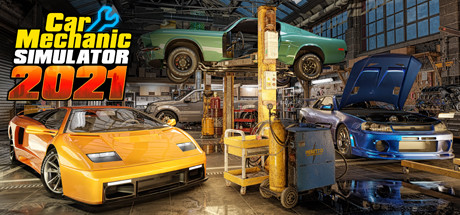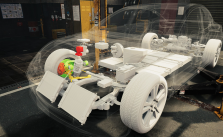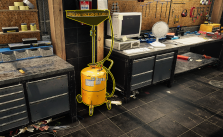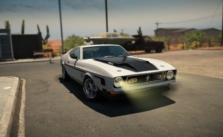Car Mechanic Simulator 2021 – Gearbox and Drivetrain
Gearbox and Drivetrain
Gearboxes. Gearboxes go bad due to low gear oil ( not too common find but not impossible ), but mainly improper shifting, causing gears to grind. Grinding gears will result in ground gear teeth, sticking gears, premature wear and tear on needle bearings, main bearings, shafts, destroyed Synchromeshs ( these are used to slow the spinning gear down during shifting ), causing stiff shifting, sticking shifting, or jumping out of gear.
Due to the number of internal parts, the gearbox can be very noisy. Worn clutch pressure plates, clutch friction plates, bad Flywheel, and clutch release bearings will also create noise. Bearings squeal during the shift; friction plate slips because it’s worn or the pressure plate surface is worn. They become bad by high mileage/hours, hot-dogging it, ridding the clutch. This will result in possible slippage, noise, gas mileage loss, or power loss because the friction plate slips at a certain speed ( the engine is revving for 50 km/h. but that trans is turning for 35Kmh because the clutch friction plate is slipping between the clutch pressure plate and flywheel ).
* How does a clutch do all that? Easy.
*You press the clutch pedal; this moves a slave cylinder, moves a clutch fork, and pushes the release bearing, that slide and press force against the diaphragm spring on the presser plate (that detail many finger objects in the center the bearing attaches to) that is pressing force back, which release the squeeze pressure from the friction disc. These assemblies are connected to the flywheel on the back of the engine that the starter uses to turn the engine over to start the car. So it is constantly spinning.
*So the bearing is spinning holding force and getting hot, gear is shifted which stops the clutch because the gearbox is “In Gear,” releasing the clutch pedal to reapply the squeeze pressure to the clutch friction plate causes a brief slip because it has to move a 10,000-pound car, and then full engagement and off the vehicle drive away usually. So with all that neat stuff, yeah, it could be destroyed. Race and drag cars are made for heavy shifting and beating on, not a factory available to the public car.
>Differential. Differential makes noises when driven with low-gear oil. Similar to the gearbox. Also, you can heat upbearing, ring gear, pinion, and spider gears. This is usually a result of hot-dogging the car by over spinning the tires, but low gear oil will also get the same result but takes longer; just hot-dogging the car is faster or instant. This will result in possible Noise, premature wear, and tare stress on drive axles.
*It’s not an engine; how does it get low gear oil? On the top of the case is a breather line or cap. It relieves pressure out of the gear case when it gets hot from the normal driving conditions. When this gets plugged, pressure can’t ventilate out. So it builds enough and forces its way out through the axle seal or gasket. Now it is leaking as it is used until there is not enough gear oil to leak out. Now your problems begin if they haven’t already…
CVC Drive axles on the modern car use CVC joints. This is so it can pivot up and down and turn right and left in front-wheel-drive cars and on rear-wheel cars to sit at an angle and pivot up and down. Front-drive axles get louder because they have to pivot not only for up and down but a harder pivot for turning left and right. This is why they get louder when they turn and quieter when they are straight. When they go bad, they have played; once they have played, they can be noisy too.
During turning, the joint is binding and popping under the stress of the road condition, the power output to the wheels, and the shifting weight of the car. They go bad for one prevalent reason. The rubber boot that covers the joint either tears, cracks, or comes off from their seal ridge. Causing road dirt, water, and the environment to ruin the grease and make the bearings rub against each other, causing friction.
Rubber boots fail from age or an improper tow. Because the tow truck driver used hooks that pressed against the boot instead of the correct tie-down attachment, or the wheel took a direct hit, this compressed the drive axle CVC joint in a manner it is not designed to do. This will result in possible noise for rear-wheel-drive cars, and front-wheel drive cars noise, and louder noise during turning and binding.
*The rear wheels? Yeah, the rear wheels. Some cars use independent suspension. So the Differential is fixed to the body. Sports cars use this system for better handling and power in turns and a better alignment for the driveshaft to the Differential. Torque loss is possible on a drive shaft fitted on a car with a Differential that moves as part of the rear suspension. Because your diverting power to the first cross and roller, then making it turn on an angle to the next, and then turn on another angle to get to the Differential. During this process, the cross and rollers are under the most stress load of power travel. But if you have a fixed Differential using independent suspension, Then the torque transfer is better, and the cross and rollers have less load stress, which is now placed in the CVC joint where it can handle it better.
*If the wheel took a direct hit, the wheel and suspension damage will be present regardless of front or rear.
Drive Shaft. When driveshafts go bad because they use cross roller style bearings at each end, this allows pivoting in rear-wheel-drive cars, so the shaft can move up and down when going over bumps without affecting the gearbox. Driveshafts go bad due to lack of grease to the cross and roller, or When they receive a direct hit someplace on the drive train causing it to bend or compress the cross and roller bearings in a manner they are not designed for, abuse, Or due to Mileage/hours. When they go bad, they make a clicking noise; the worse they get, the more the cross and roller risks breaking and ejecting the drive shaft.
*On some cars with drive shafts, you will see a small plate bolted to the body just under the driveshaft. This is an emergency catch if the cross and roller fail, and under a load, they tend to fail badly; this catch plate is supposed to prevent the driveshaft from ejecting from under the car. The outcome is very aggressive, Your talking about a sudden release of power in a single blow.
*It is ideal when changing the oil to grease the cross and rollers beside the front suspension by filling through the grease zerks/plugs. When pupping grease into a grease zerk on a cross and roller, what your looking for is what happens when the grease starts to seep past the seal, nothing or did it shift, and if it shifts, how bad. Also, can you make the shaft shift by wiggling it? This is important because it is a sign of worn bearings, the more, the worst. Using inspection mode would be simulating this action.








